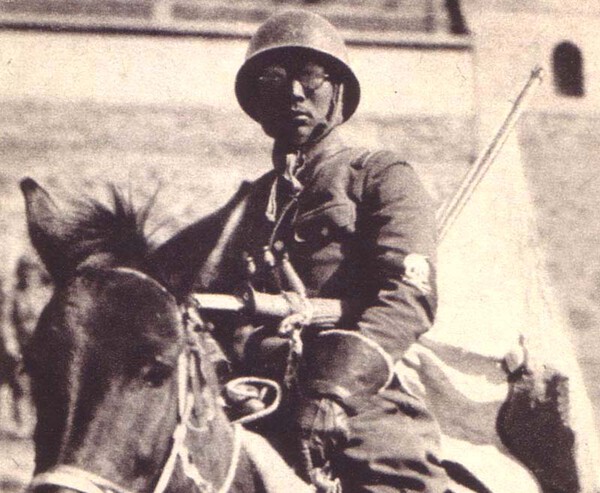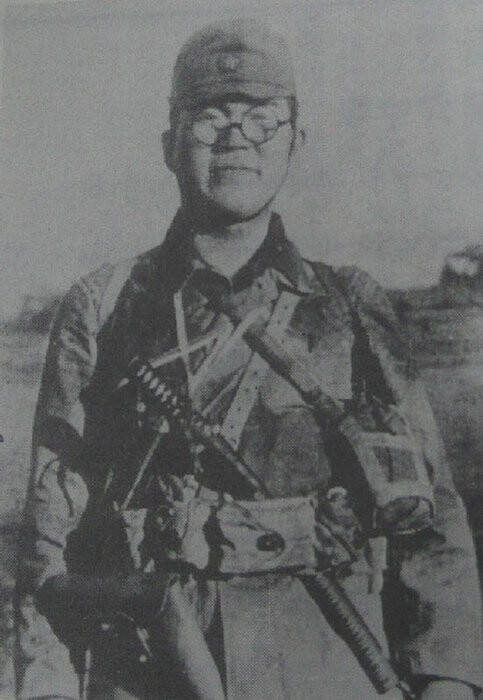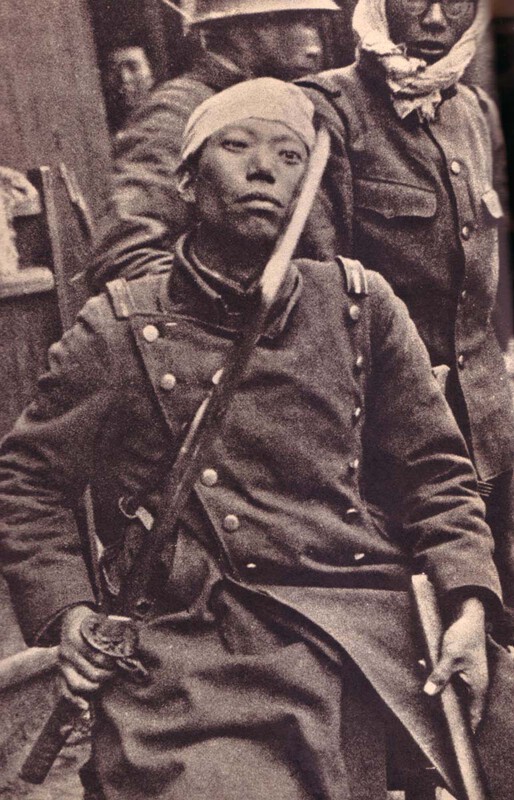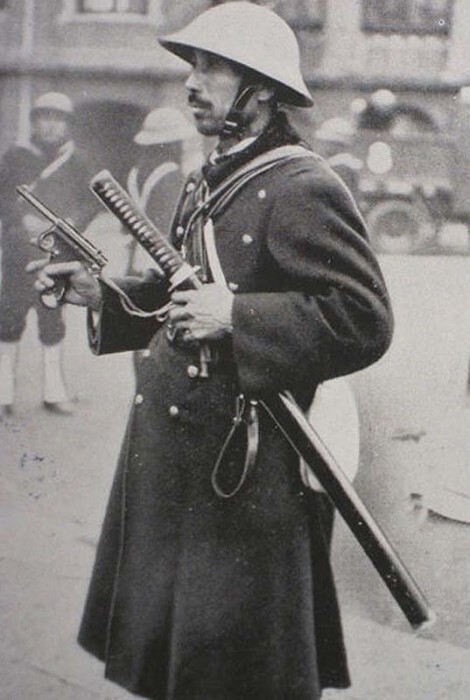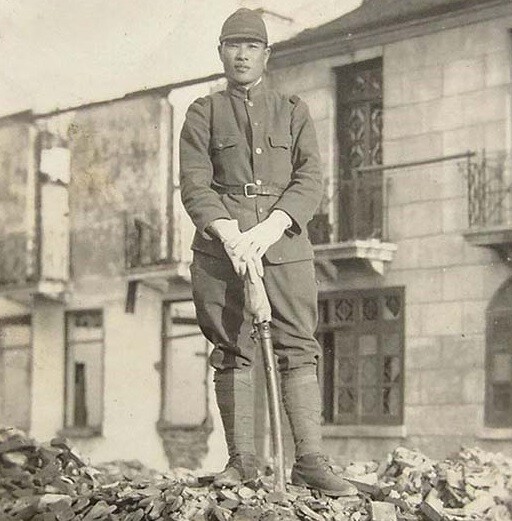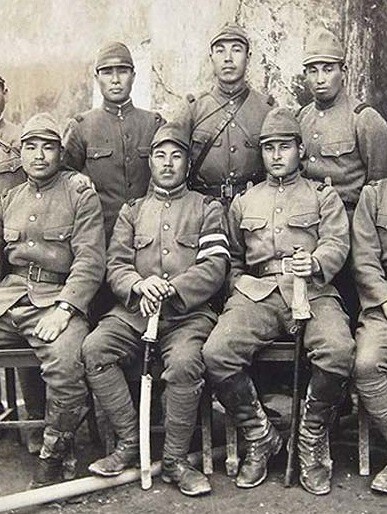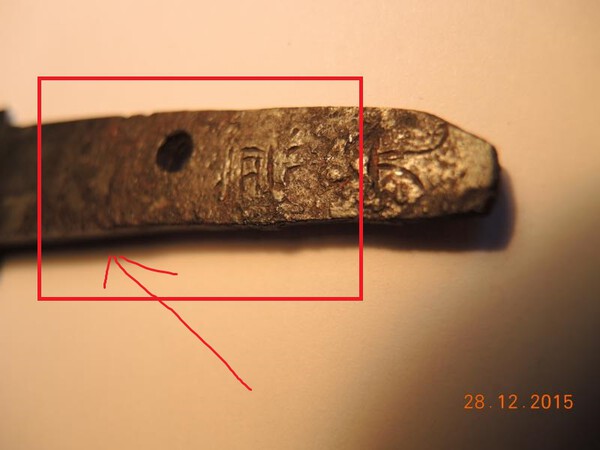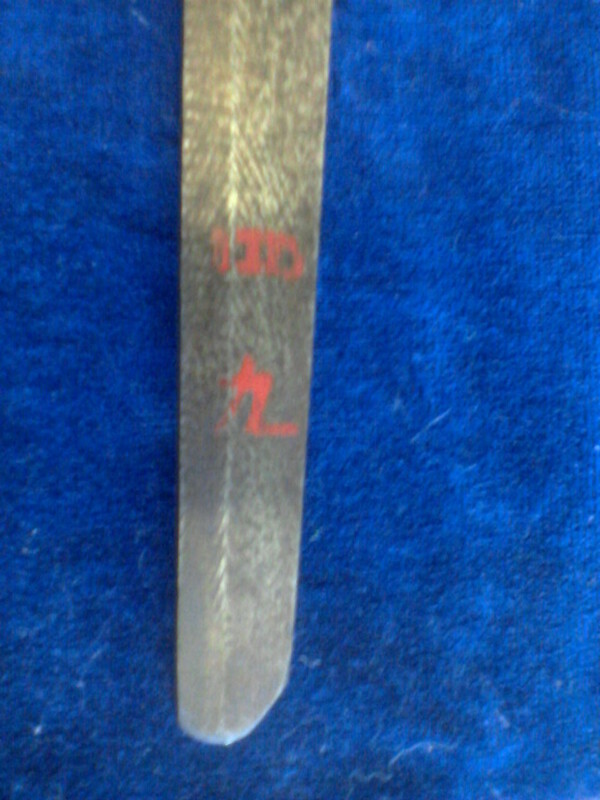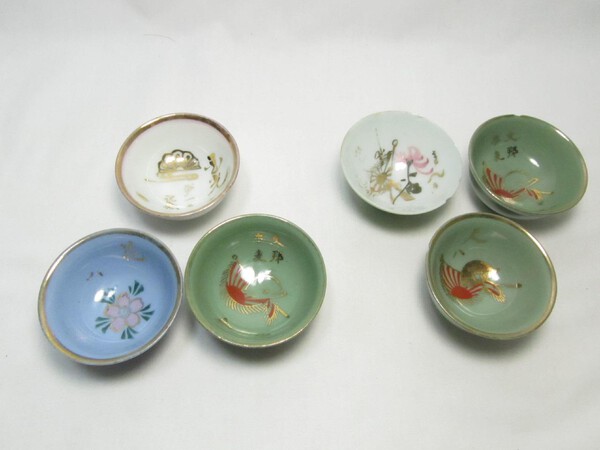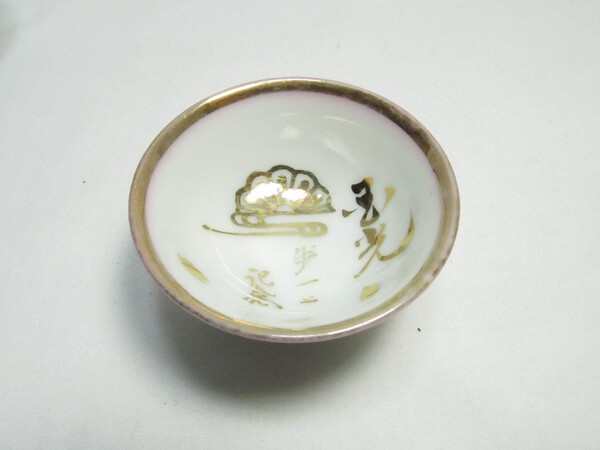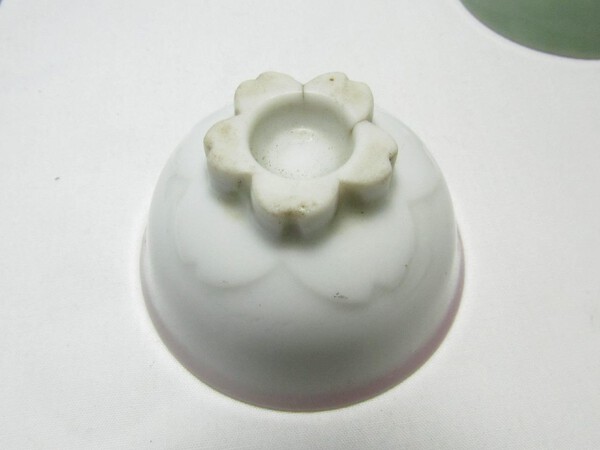-
Posts
1,691 -
Joined
-
Last visited
-
Days Won
11
Content Type
Profiles
Forums
Events
Store
Downloads
Gallery
Everything posted by Dave R
-
If you hop across to the Military Swords of Japan section you will get some useful information. The Showa stamp means a non traditionally made blade, my guess is for a han-tan-to or tanren-to or something like. The Army acceptance stamp is the star stamp. More information on Showa forging types here. http://www.ksky.ne.jp/~sumie99/sunobe.html
-
-
Well I am certainly still interested. I would say that the first sword is certainly a "Satsuma/Okashi-to" due to the Ito going over the Kashira. The other I am not so sure of. My whole aim with the thread was to garner examples and work towards a consensus as to what defined this type as opposed to other swords with this variant of katatamaki, and get some idea as to what they really were. ..... Edit, yes the second is definitely one as well, I missed the washer style menuki at first look.
-
Hiya, is the blade an old one or Showato? When you say made for the blade, do you mean the wooden liner?
-
The Shin-Gunto was a required item of an officers uniform, he would be improperly dressed without one, to that I think you can add the Japanese reverence for the sword and the moral effect of carrying one. I have also seen on Ohmura's site and elsewhere some very practical mounts for shorter blades, evidently intended for use either as a survival tool or a close combat weapon. As a footnote here are two pics of traditional wakizashi carried into combat, one in Manchuria pre-dating WW2 and one at the very end of the war.
-
Hiya Hamish, yes all those swords illustrated are in traditional mounts. I have been collecting photo's from the internet for a while, of Japanese officers with "variant" swords. I have for some time been thinking about the whole subject of "ancestral blades" and non standard koshirae, and went looking for evidence of what was actually carried in action. There is a surprising amount of stuff out there to see and had already concluded that a lot of them were just "old swords" rather than "family heirlooms". I could go on at length, but will not do so here. I believe an antique blade in a full formal Shin-Gunto koshirae is a rarity, and to my mind indicates the outlay of some serious money and deliberate choice rather than just the carrying of what was available. I am inclined to agree with you about the definition of a "Crew Gunto", regarding proportions and mounts. It would be interesting to see how many of them utilise an old Wakizashi blade and how many if any of them have a Showa era blade, either traditionally made or in modern steel!
-
"I quickly scanned over the war relics page, and didn't find any relation to the subject at all." What I was trying to link to was the article about "so called type 3 gunto". In it there are references to problems with sword production during the War. One of the "emergency measures, Rinji 臨時", being officers allowed to use their own swords, and another the setting up of an official Military Board to buy old blades and re-purpose them as Gunto. Quote from the article... " The Military Sword Appraisal Committee formed in late 1938 as a joint program between the army and navy officer clubs, the Kaikosha and Suikosha and the Gunjinkaikan supported by the Army and Navy Ministries. The purpose was to buy up family Samurai swords that could be made into army and navy Guntos. Appraisers and affiliated dealers got together to offer you a fair price for swords you brought in." ..... This I believe would explain a lot of the non standard blades found in Shin Gunto mounts. Looking on-line at photo's of Japanese Officers in action I saw a surprising number of shorter swords in use, and others of normal length with no attempt made to mount them in standard Shin-Gunto Koshirae, carried into action and worn with the uniform. Returning to the sword in question, the Koshirae and blade are very nice indeed and the whole package definitely a desirable one!
-
I think the "rare" bit is that it is a short non standard blade with a made to measure steel saya. How rare is another matter, Ohmura shows a couple of such on his site. http://ohmura-study.net/761.html. With what I have seen elsewhere I would debate these being crew gunto or even "ancestral" blades though. Have a look here for some idea as to what these might be,... http://www.warrelics.eu/forum/Japanese-militaria/deflating-another-myth-type-3-army-officer-s-sword-expanded-version-584796/ read the whole article to see what I mean.
-
It all depends on what you are looking for, does it not. Militaria and Nihonto are judged by different criteria. I have seen some very shabby Gunto and even NCO swords go for over $800 and Hanwei does a replica at over $1,000.
-
Wood fillets or strips were usually the traditional answer to loose fitting tsuka, one tanto I had years ago had a large wood shaving as the filler. Or for a very loose fit, you could try this. Use Honoki for fillers and inserts, if you cannot buy it from Namikawa buy an old Shirasaya from Fleabay and use it as material.
-

Celluloid Same of WWII...and Type 3 mon.
Dave R replied to george trotter's topic in Military Swords of Japan
Shark, aka "shagreen" was also used on traditional Tsuka in the Edo period. I have a Wakizashi Tsuka in my collection with such under the Ito just as Samagawa is so often used. https://en.wikipedia.org/wiki/Shagreen -
Meiji, Taisho and Showa period Japanese were well aware of the limitations of traditional swords, and while some preserved the tradition others went beyond. That's how you ended up with Koa-Ishin blades, where the latest technology was used to produce swords that kept to some part of the tradition. Ohmura goes into some detail about the changes and details and his site is a must for anyone interested in Shin Gunto... http://ohmura-study.net/900.html. On another note, here is a link to an interesting discussion about the above article.... http://www.e-budo.com/archive/index.php/t-28903.html Dave
-
I had the opportunity today to re-read Fuller and Gregory's book on Imperial Japanese swords where on page 219 they described the production of Mantetsu-to. "The steel was rolled into basic shaped rods (ie, shinogi, mune etc.) This was then cut into the right lengths, tapered, kisaki and nakago pounded out, tempered, polished and signed."...N.B. The curve would appear during tempering of the edge. This then reminded me of the workshop of a modern Western sword maker, Paul Binns, where I saw vintage/antique bar stock that had been rolled out to the cross section of a typical western sabre with fuller and wedge section edge. These he was then forging into sabres for re-enactors, and in fact I have one of them that I carry at Napoleonic events.(This particular piece is often taken for an original, so they do make quite decent swords.) Dave
-
Looking at my most recent acquisition a Kaneyoshi Shin-Gunto I noticed that the edge section was a flat V section rather than the clamshell section of most Nihonto. Is this a common feature of Showato? Possibly a reflection of the lack of body armour worn in WW2,.... lack of skill on the part of individual smiths,..... or a feature of this swordsmith alone? Or am I just reading too much into a mere result of rapid production of a wartime blade. Dave.
-
-
Aha, Orikaeshi-Mei, extreme shortening of the tang with the signature preserved..... http://www.ksky.ne.jp/~sumie99/suriage.html
-
To me this looks like a decent old blade, brought back from a very dilapidated condition by a serious polishing job. I have seen a few such over the last few years, sometimes blades I have turned down because I thought they were beyond redemption have turned out really well. This would explain the state of the nakago.
-
Given Japan's rapid modernisation during the Meiji era I have little doubt that they imported sword and bayonet making machinery and techniques from Europe and America. Certainly their Cavalry sabres type 38 were made in a very modern style, though the blade shape was reminiscent of traditional katana. I would suggest having a look at Solingen's factories for ideas of how these were made. The same production methods would then be used for the NCO's type 95 and the lower end Commissioned Officers Shin Gunto. I also suspect that as the Army expanded and production capacity was strained that a lot of later blades were "Cottage Industry" produced and a lot of variation seen in their production methods and quality.
-
Am I right in thinking that the lack of any type of stamp denotes an earlier blade, or does it have some other significance?
-
Greetings all, and may I present to you my first Shin-Gunto, all my other blades are Nihonto so this is a foray into new territory for me. I know very little about this blade other than that it is a Showa era military blade, with a nagasa of 64cm or just a tad over 25 inches which is short for one of these, but it is the original length. Only "signed" on the one side, but no one in my club was able to give me any ideas about the translation, I think it is out of area for most of them. Some idea of date or maker would be greatly appreciated. I am not expecting or wanting anything special, I am just hoping for a decent war time blade. A close inspection revealed no stamps of any kind so I think it's an earlier blade made before the stamps were obligatory.
-

Introduction And First Gendaito (Warning: Picture Heavy)
Dave R replied to Pteradon's topic in Military Swords of Japan
It's a very poor condition Tabagatana that I am treating as a project. Tired and bashed but no fatal flaws, and yes it is a long blade. -

Introduction And First Gendaito (Warning: Picture Heavy)
Dave R replied to Pteradon's topic in Military Swords of Japan
-

Looking For Some Help With My Newest Sword
Dave R replied to John Miller's topic in Military Swords of Japan
Not as unusual as you may think....Due to shortages of blades the Japanese military had a couple of initiatives that resulted in the re-use of old blades. Information here...http://www.wehrmacht-awards.com/forums/showthread.php?t=824972 Here...http://ohmura-study.net/977.html And a cutting from the To-Ken Soc. -
I am not sure this is the best place to post, but it is Militaria and so I am starting here. I recently won a bunch of Japanese military Sake cups, Heitai Sakazuki Gunpai as they were called. One of them especially caught my eye having the "Floating Chrysanthemum" on it. Would this be a generally used symbol or would it have some particular significance referencing the Minatogawa Shrine? Many thanks to everyone for your time, it would be nice if someone can tell me a bit more about this one.
-

Help Identifying A Ww Ii Arisaka Bayonet Handle Cut/name
Dave R replied to flemming7x64's topic in Military Swords of Japan
Given that it is a bayonet rather than a sword, you might have more luck with your questions here..... http://www.warrelics.eu/forum/Japanese-militaria/



